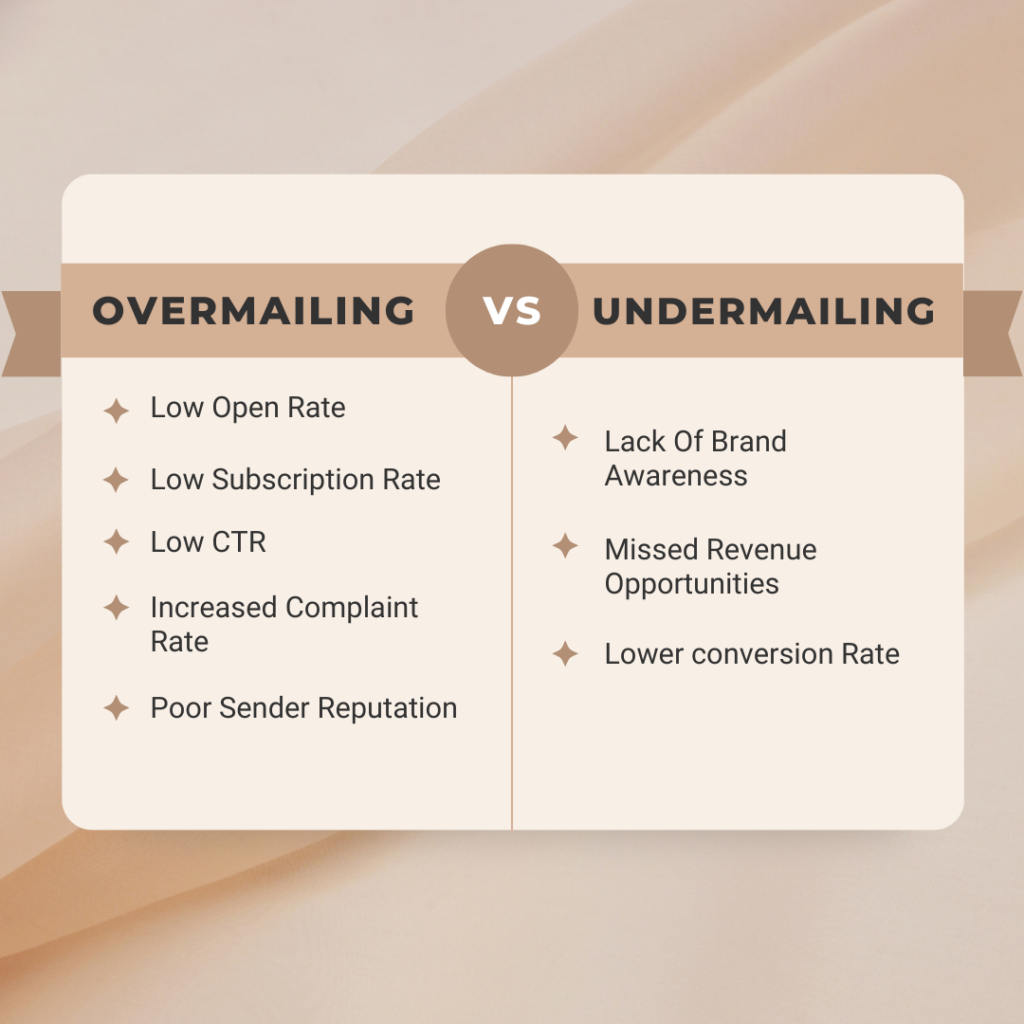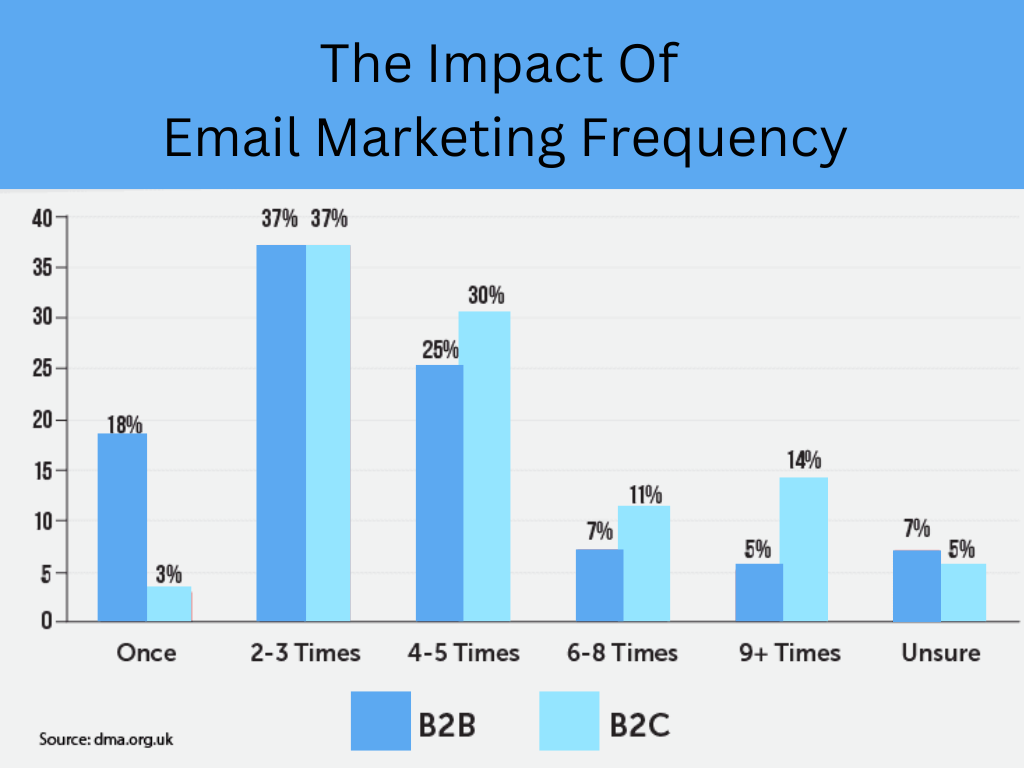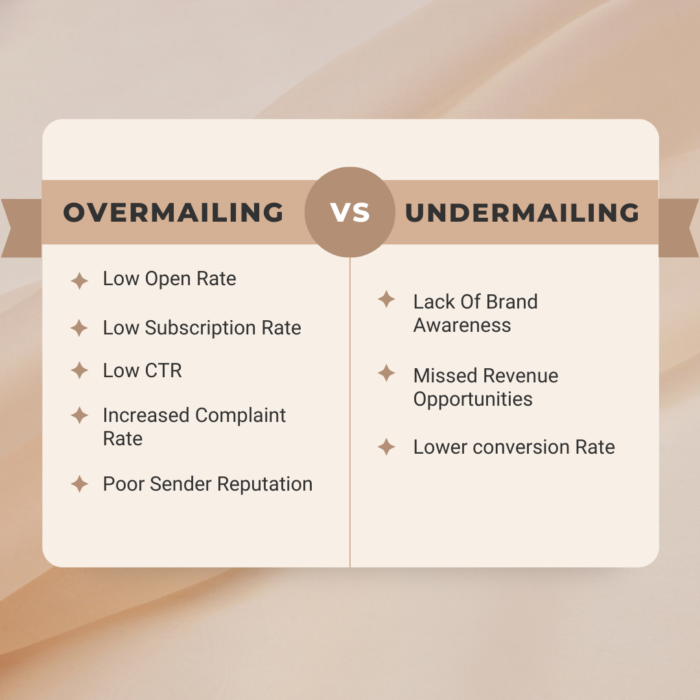How often should I send marketing emails? This is so far one of the most asked questions, I have come across.
But there is no single definitive answer to it. However, learning about the factors that can influence email marketing frequency will help you plan a complete email-sending schedule.
In this guide, we will cover the same. But before that let’s learn why is it important to define the right email marketing frequency for your business.
Table of contents
1. Why finding the right email marketing frequency is crucial?
2. How often should you send marketing emails?
2.1 Industry
2.2 Nature of your product/service and its need
2.3 Your customers’ behavior and demographics
3. Conclusion
4. FAQs
Why finding the right email marketing frequency is crucial?
If you don’t set the right email marketing frequency, it greatly affects your open rate, click-through rate, complaint rate, subscription rate, and sender reputation.
Why?
If you tend to send your marketing emails too frequently (over-mailing), chances are high that your subscribers will get annoyed. While rarely sending emails (under-mailing) will not register your brand in your potential customer’s mind.

Impact of over-mailing on your campaign
Over-mailing will affect your results in the following ways:
- Low open rate:
Would you open an email from a company that spams you with multiple messages? I wouldn’t.
In the same way, your recipients will start ignoring all the messages from your brand. This will drastically reduce your open rate.
- Low click-through rate
CTR is another key factor that helps you measure the success of your email marketing campaign. Once, there is a drop in your open rate due to over-mailing, your click-through rate automatically drops.
- Increased complaint rate
Customer satisfaction matters!
Spamming your customers with too many emails within a short period of time will annoy them. Though some may decide to ignore it, majority of people will raise a complaint out of frustration.
The rise in the complaint rate will increase the chances of your campaign failure.
Hence, you must spend a lot of time analyzing how comfortable your recipients are in receiving your emails and act accordingly.
- Low subscription rate
Over mailing is the main reason why people choose to unsubscribe or opt-out. Moreover, it affects you end up leaving that customer with a bad experience. This affects your brand image.
- Poor sender reputation
The decrease in open rate, CTR, subscription rate, and the increase in complaint rates due to over-mailing will badly affect your sender reputation. Eventually, leading to a failed email marketing campaign.
Impact of under-mailing on your campaign
The following are the 3 possible outcomes of under mailing:
- Lack of brand awareness
You may send emails to lakhs of people. But keeping the sending frequency too low will affect your inbox presence. Hence, you won’t be able to register your brand in your customers’ mind.
This will eventually lead to consumers forgetting about your business.
- Missed revenue opportunities
You may lose the chance to connect with your potential customers by limiting the number of emails sent. Thus, many consumers would move away from your brand.
This will ultimately lead to destroying your revenue opportunities.
- Low conversion rate
Nurturing your leads is essential to drive sales. You can only do this by keeping them engaged with sequential emails sent at the right frequency.
The lesser emails you send to your potential customer, the more they move away from your business. This drastically affects your conversion rate.
So, what to do?
The main agenda here is to establish a balance between over-mailing and under-mailing. Here are some best practices from the industry to do so.
How often should you send marketing emails?
Here are a few factors you need to consider while deciding your email marketing frequency rate.
1. Industry
No matter, whether you are a B2B or B2C business, email is a great way to keep you on the top of the mind of your potential customers.
However, the email marketing frequency differs slightly depending on the type of business you are in.
Why?
Because the email-sending pattern affects the conversion rate differently for B2B and B2C businesses. Moreover, the purchasing behaviors and buying cycles of B2B and B2C customers also differ. You ca see it in the following the graph from CoSchedule:

Hence, your sending pattern should also be different.
- Email Marketing Frequency for B2B businesses
The clients for B2B businesses are limited. Hence, the main aim here is to nurture leads, build a trustworthy relationship, and eventually drive conversion.
So, B2B emails require to be disciplined. You, of course, don’t want to lose your lead by spamming your potential client, plus, register your business in their mind at the same time.
For instance, if you have promised to send a weekly email to your customer, the same will be expected. You need to meet their expectation.
However, if you fail to do so, they are more likely to distrust your business and unsubscribe.
The best practice here that most B2B businesses follow is to send 2 emails per month.
- Email marketing frequency for B2C businesses:
Most B2C businesses are based on emotion-based purchases. The customers here are more driven by promotions and new releases. Plus, the consumer market is wide.
Hence, B2C emails should be sent more frequently as compared to B2B businesses.
In case, you are just starting your email marketing campaign, the best practice here is to send 4 to 6 emails per month.
But if your email id already has a good sender reputation, you can eventually rise the number of emails sent to 10-19 per month as per the research done by Omnisend.
2. Nature of your product/service and its need
The frequency of emails sent also largely depends on what kind of products/services you offer. Plus their need in the market.
For instance, if there is a burning need for a product/service in the market, you will need to increase your email marketing frequency. This will help you create a strong presence in your potential customer’s inbox and thus choose you over your competitors.
But, if there is too little need for your product/service, you will need to lower your email marketing frequency, thus, nurturing your leads, and eventually converting them.
3. Your customers’ behavior and demographics
Understanding your customers’ behavior and demographics is the most crucial step while deciding how frequently you should send your marketing emails.
Hence, closely observe your audiences’ behavioral patterns based on their demographics.
For instance, a segment of mid-aged women is showing more interest in buying your skin care product on Sundays.
Here, we have considered two demographics- age and gender. Plus, their behavioral pattern shows us that running campaigns once every Sunday drives more sales.
So, you can plan to send your emails once every week on Sunday for that particular segment.
Wrapping up
There is no definite single answer for deciding how often should you send your marketing emails.
You need to decide it depending on your campaign results, your industry, the nature of your product/service, and your audience’s demographics and behavioral pattern.
So, just get started, analyze your first email marketing campaign, and let it help you set your email marketing frequency.
Once, you identify your marketing email sending frequency, consider using a cold email automation tool like SafeMailer to simplify your task. This tool will help you efficiently generate and nurture leads by mimicking a human-like sending pattern.
FAQs
Q. What is the ideal frequency for sending marketing emails?
It is recommended to strike a balance between staying top-of-mind and not overwhelming your audience. Generally, a frequency of 1-3 emails per week is considered suitable.
Q. Does the type of business impact the email frequency?
Absolutely. The nature of your business and the preferences of your audience play a crucial role. For instance, a daily deal site might send more frequent emails compared to a monthly newsletter for a specialized service.
Q. How can I determine the optimal email frequency for my audience?
Conduct A/B testing with different frequencies to gauge audience response. Monitor open rates, click-through rates, and unsubscribe rates to identify the sweet spot that resonates with your subscribers.
Q. Should I consider the content relevance along with frequency?
Definitely. Quality content is as important as frequency. Ensure your emails provide value to your audience. Irrelevant content can lead to higher unsubscribe rates, regardless of the frequency.
Q. What are the potential drawbacks of sending emails too frequently?
Overloading your subscribers with too many emails can lead to fatigue and annoyance. This may result in increased unsubscribe rates and a negative impact on your brand reputation.
Q. Is there a ‘one-size-fits-all’ approach to email frequency?
No, there isn’t. Every audience is unique. Pay attention to engagement metrics and adjust your frequency accordingly. Some audiences may respond well to daily emails, while others prefer a weekly or monthly cadence.
Q. Are there specific days or times that are better for sending marketing emails?
The ideal timing can vary based on your audience’s habits. Test different days and times to determine when your emails are most likely to be opened and engaged with.
Q. How can I manage the expectations of my subscribers regarding email frequency?
Be transparent with your subscribers about the frequency they can expect when they sign up. Setting expectations from the beginning can reduce the likelihood of dissatisfaction.
Q. Should I consider the industry benchmarks for email frequency?
While industry benchmarks can provide insights, it’s essential to prioritize your audience’s preferences. Use benchmarks as a reference but focus on what works best for your specific audience.


Leave a Reply